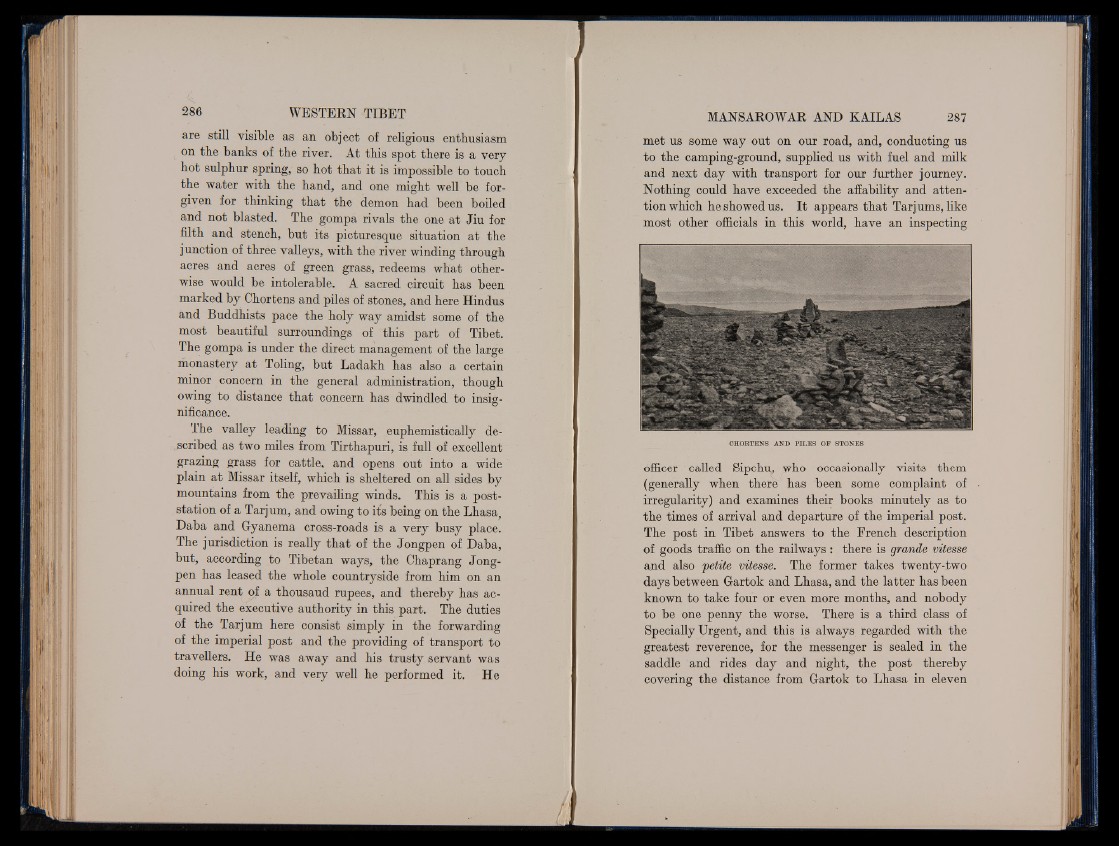
are still visible as an object of religious enthusiasm
on the banks of the river. At this spot there is a very
hot sulphur spring, so hot that it is impossible to touch
the water with the hand, and one might well be forgiven
for thinking that the demon had been boiled
and not blasted. The gompa rivals the one at Jiu for
filth and stench, but its picturesque situation at the
junction of three valleys, with the river winding through
acres and acres of green grass, redeems what otherwise
would be intolerable. A sacred circuit has been
marked by Chortens and piles of stones, and here Hindus
and Buddhists pace the holy way amidst some of the
most beautiful surroundings of this part of Tibet.
The gompa is under the direct management of the large
monastery at Toling, but Ladakh has also a certain
minor concern in the general administration, though
owing to distance that concern has dwindled to insignificance.
The valley leading to Missar, euphemistically described
as two miles from Tirthapuri, is full of excellent
grazing grass for cattle, and opens out into a wide
plain at Missar itself, which is sheltered on all sides by
mountains from the prevailing winds. This is a poststation
of a Tarjum, and owing to its being on the Lhasa,
Daba and Gyanema cross-roads is a very busy place.
The jurisdiction is really that of the Jongpen of Daba,
but, according to Tibetan ways, the Chaprang Jongpen
has leased the whole countryside from him on an
annual rent qf a thousaud rupees, and thereby has acquired
the executive authority in this part. The duties
of the Tarjum here consist simply in the forwarding
of the imperial post and the providing of transport to
travellers. He was away and his trusty servant was
doing his work, and very well he performed it. He
met us some way out on our road, and, conducting us
to the camping-ground, supplied us with fuel and milk
and next day with transport for our further journey.
Nothing could have exceeded the affability and attention
which he showed us. I t appears that Tarj urns, like
most other officials in this world, have an inspecting
CHORTENS AND P IL E S OF STONES
officer called Sipchu, who occasionally visits them
(generally when there has been some complaint of
irregularity) and examines their books minutely as to
the times of arrival and departure of the imperial post.
The post in Tibet answers to the French description
of goods traffic on the railways : there is grande vitesse
and also petite vitesse. The former takes twenty-two
days between Gartok and Lhasa, and the latter has been
known to take four or even more months, and nobody
to be one penny the worse. There is a third class of
Specially Urgent, and this is always regarded with the
greatest reverence, for the messenger is sealed in the
saddle and rides day and night, the post thereby
covering the distance from Gartok to Lhasa in eleven